Abstract
Formestane is a selective inhibitor of oestrogen synthesis by aromatase enzymes and induces disease regression in breast cancer patients. This phase II randomised study was carried out to determine whether there were any differences in the effects of two different doses of formestane on oestradiol (E2) serum levels and to evaluate the corresponding clinical activity in post-menopausal patients with positive or unknown oestrogen receptor status pretreated or not for advanced disease. Furthermore, possible drug interference with adrenal steroidogenesis was assessed by measuring 17-hydroxycorticosteroid (17-OHCS) urinary levels. A total of 143 patients entered the study and were randomly assigned to receive formestane 250 mg (72 patients) or formestane 500 mg (71 patients), both given i.m. every 2 weeks. In comparison with baseline, E2 serum levels decreased by an average of 40% after only 15 days and remained unchanged thereafter, with no difference being observed between the two doses. The values of 17-OHCS remained unchanged during treatment in both groups. Objective responses were 28% (19/69) in the 250 mg and 46% (31/68) in the 500 mg group. In conclusion, the two formestane doses were equally effective in reducing E2 levels without affecting adrenal function, and in inducing a considerable percentage of clinical responses.
Full text
PDF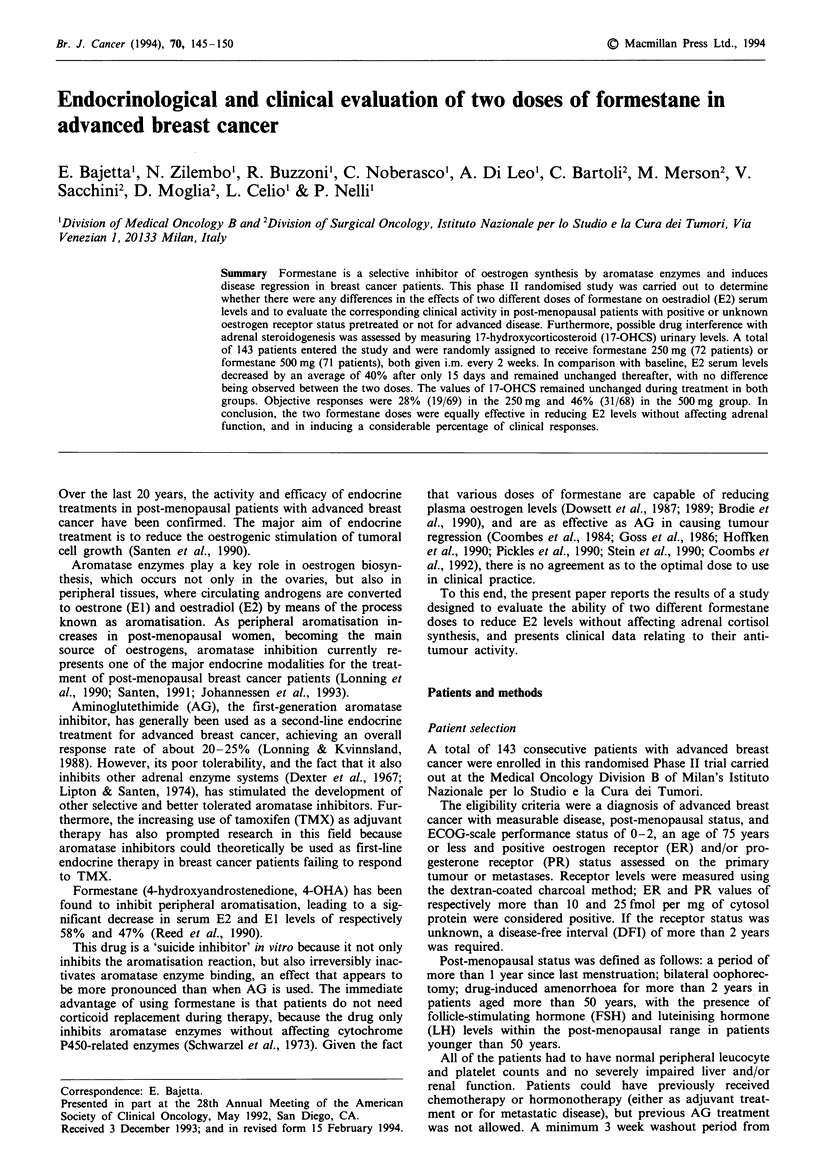
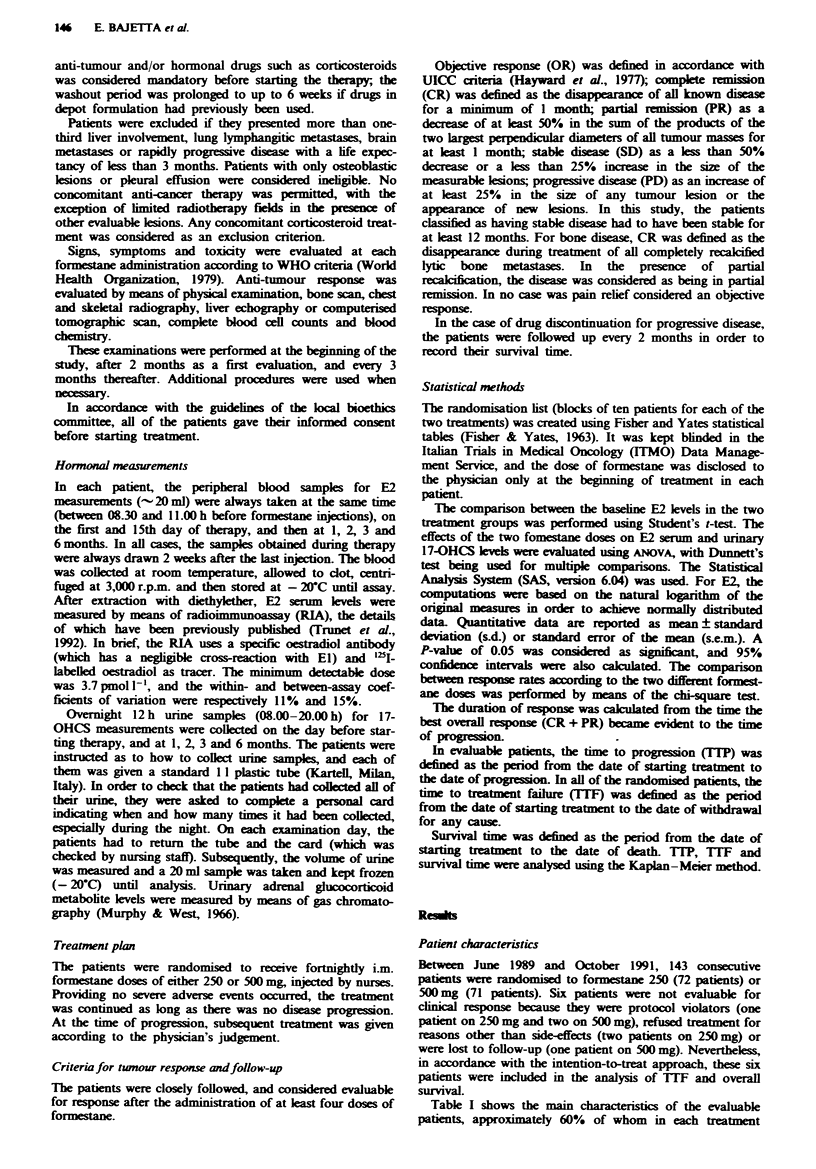
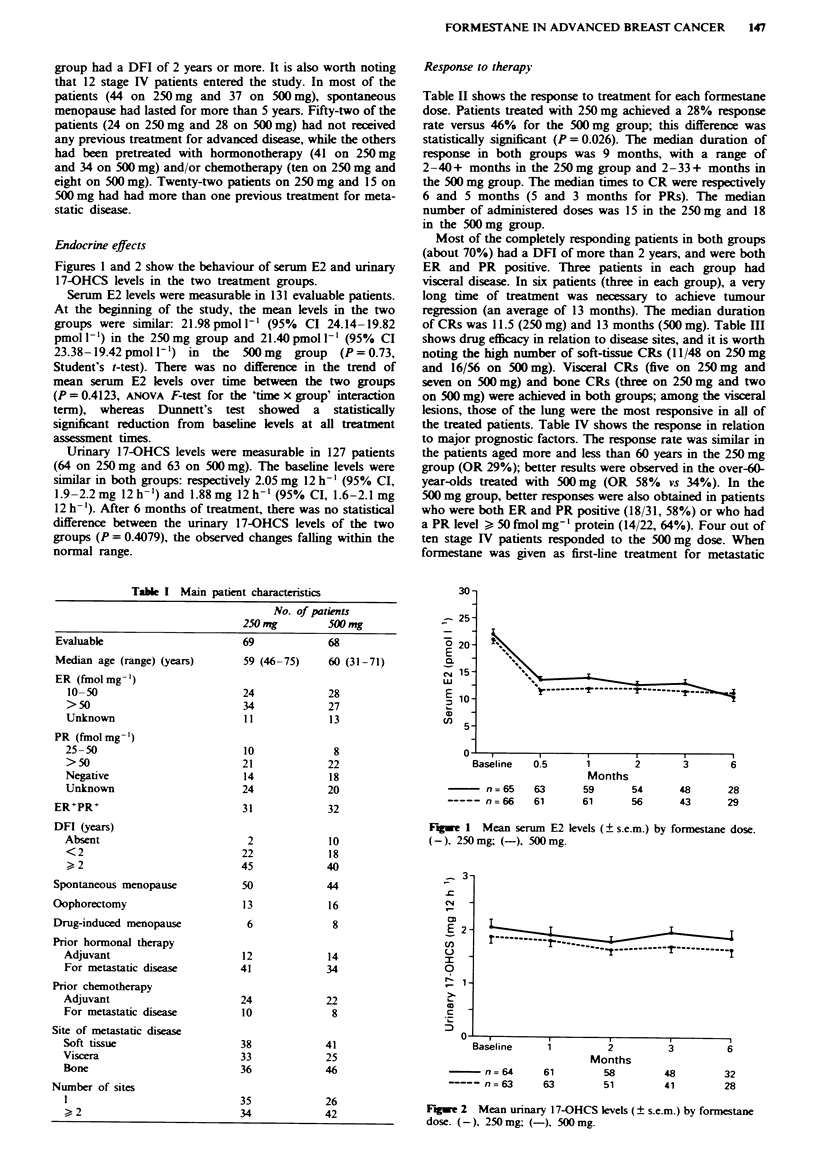
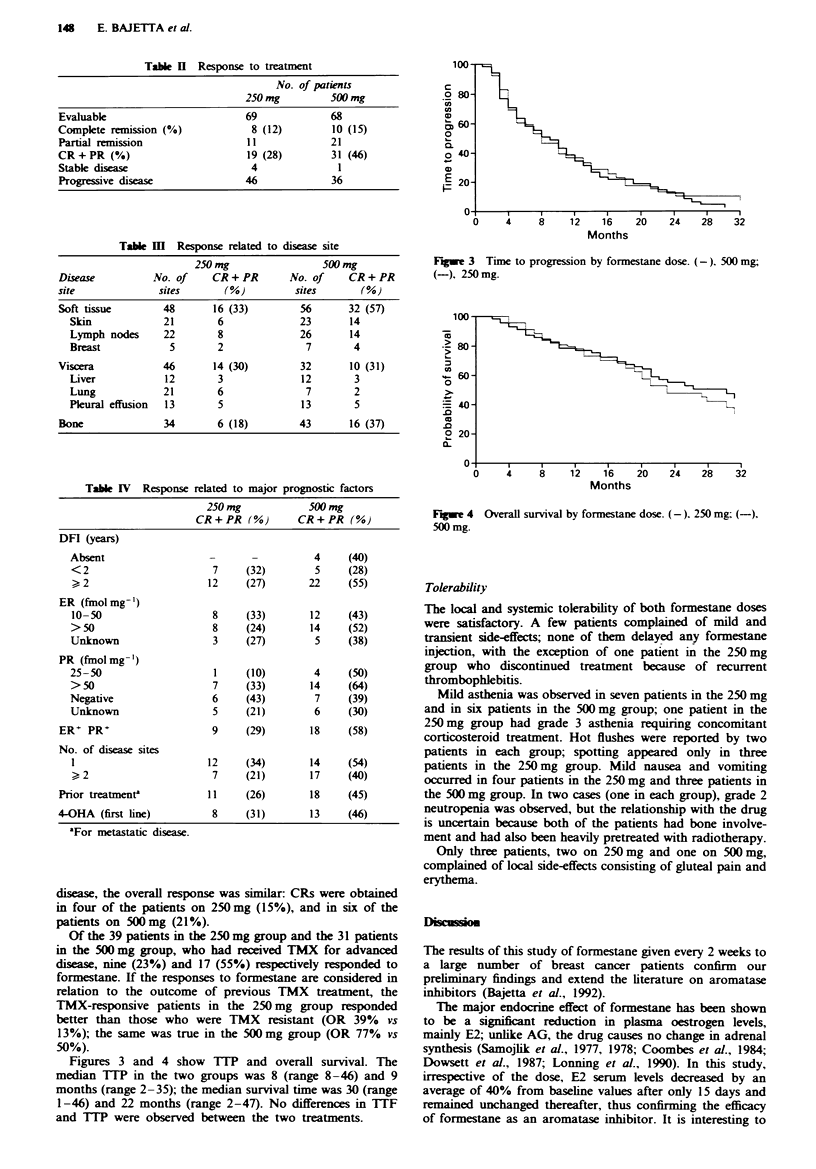
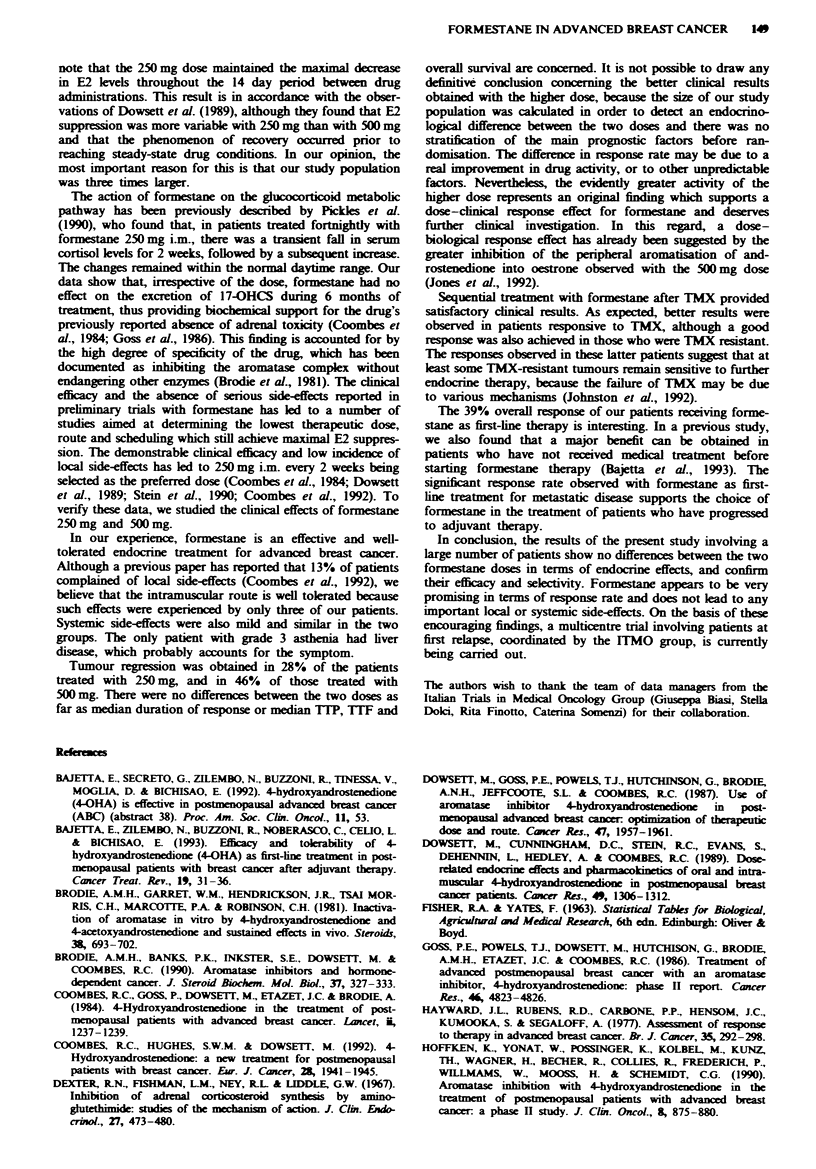
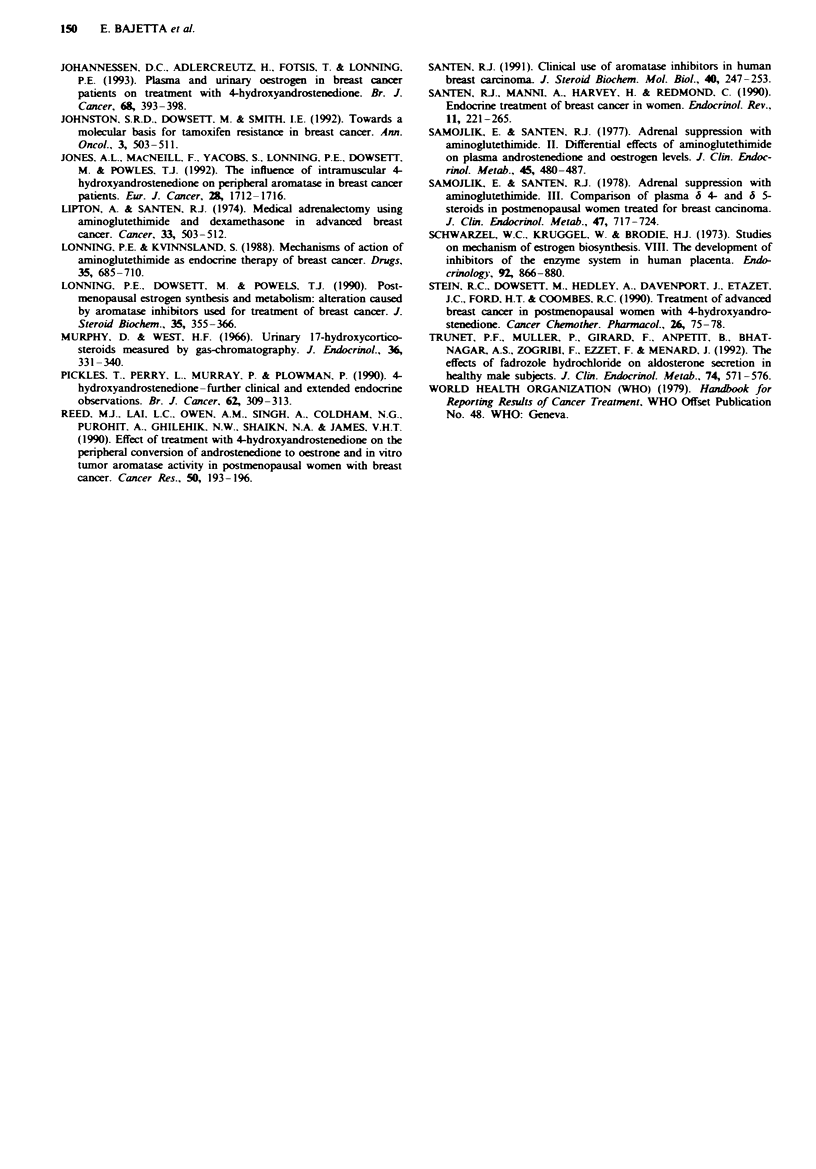
Selected References
These references are in PubMed. This may not be the complete list of references from this article.
- Bajetta E., Zilembo N., Buzzoni R., Noberasco C., Celio L., Bichisao E. Efficacy and tolerability of 4-hydroxyandrostenedione (4-OHA) as first-line treatment in postmenopausal patients with breast cancer after adjuvant therapy. Cancer Treat Rev. 1993 Apr;19 (Suppl B):31–36. doi: 10.1016/0305-7372(93)90005-c. [DOI] [PubMed] [Google Scholar]
- Brodie A. M., Banks P. K., Inkster S. E., Dowsett M., Coombes R. C. Aromatase inhibitors and hormone-dependent cancers. J Steroid Biochem Mol Biol. 1990 Nov 20;37(3):327–333. doi: 10.1016/0960-0760(90)90481-y. [DOI] [PubMed] [Google Scholar]
- Brodie A. M., Garrett W. M., Hendrickson J. R., Tsai-Morris C. H., Marcotte P. A., Robinson C. H. Inactivation of aromatase in vitro by 4-hydroxy-4-androstene-3,17-dione and 4-acetoxy-4-androstene-3,17-dione and sustained effects in vivo. Steroids. 1981 Dec;38(6):693–702. doi: 10.1016/0039-128x(81)90087-8. [DOI] [PubMed] [Google Scholar]
- Coombes R. C., Goss P., Dowsett M., Gazet J. C., Brodie A. 4-Hydroxyandrostenedione in treatment of postmenopausal patients with advanced breast cancer. Lancet. 1984 Dec 1;2(8414):1237–1239. doi: 10.1016/s0140-6736(84)92795-8. [DOI] [PubMed] [Google Scholar]
- Coombes R. C., Hughes S. W., Dowsett M. 4-hydroxyandrostenedione: a new treatment for postmenopausal patients with breast cancer. Eur J Cancer. 1992;28A(12):1941–1945. doi: 10.1016/0959-8049(92)90232-q. [DOI] [PubMed] [Google Scholar]
- Dexter R. N., Fishman L. M., Ney R. L., Liddle G. W. Inhibition of adrenal corticosteroid synthesis by aminoglutethimide: studies of the mechanism of action. J Clin Endocrinol Metab. 1967 Apr;27(4):473–480. doi: 10.1210/jcem-27-4-473. [DOI] [PubMed] [Google Scholar]
- Dowsett M., Cunningham D. C., Stein R. C., Evans S., Dehennin L., Hedley A., Coombes R. C. Dose-related endocrine effects and pharmacokinetics of oral and intramuscular 4-hydroxyandrostenedione in postmenopausal breast cancer patients. Cancer Res. 1989 Mar 1;49(5):1306–1312. [PubMed] [Google Scholar]
- Dowsett M., Goss P. E., Powles T. J., Hutchinson G., Brodie A. M., Jeffcoate S. L., Coombes R. C. Use of the aromatase inhibitor 4-hydroxyandrostenedione in postmenopausal breast cancer: optimization of therapeutic dose and route. Cancer Res. 1987 Apr 1;47(7):1957–1961. [PubMed] [Google Scholar]
- Goss P. E., Powles T. J., Dowsett M., Hutchison G., Brodie A. M., Gazet J. C., Coombes R. C. Treatment of advanced postmenopausal breast cancer with an aromatase inhibitor, 4-hydroxyandrostenedione: phase II report. Cancer Res. 1986 Sep;46(9):4823–4826. [PubMed] [Google Scholar]
- Hayward J. L., Carbone P. P., Heusen J. C., Kumaoka S., Segaloff A., Rubens R. D. Assessment of response to therapy in advanced breast cancer. Br J Cancer. 1977 Mar;35(3):292–298. doi: 10.1038/bjc.1977.42. [DOI] [PMC free article] [PubMed] [Google Scholar]
- Johannessen D. C., Adlercreutz H., Fotsis T., Lønning P. E. Plasma and urinary oestrogens in breast cancer patients on treatment with 4-hydroxyandrostenedione. Br J Cancer. 1993 Aug;68(2):393–398. doi: 10.1038/bjc.1993.347. [DOI] [PMC free article] [PubMed] [Google Scholar]
- Johnston S. R., Dowsett M., Smith I. E. Towards a molecular basis for tamoxifen resistance in breast cancer. Ann Oncol. 1992 Jul;3(7):503–511. doi: 10.1093/oxfordjournals.annonc.a058251. [DOI] [PubMed] [Google Scholar]
- Jones A. L., MacNeill F., Jacobs S., Lonning P. E., Dowsett M., Powles T. J. The influence of intramuscular 4-hydroxyandrostenedione on peripheral aromatisation in breast cancer patients. Eur J Cancer. 1992;28A(10):1712–1716. doi: 10.1016/0959-8049(92)90074-c. [DOI] [PubMed] [Google Scholar]
- Lipton A., Santen R. J. Proceedings: Medical adrenalectomy using aminoglutethimide and dexamethasone in advanced breast cancer. Cancer. 1974 Feb;33(2):503–512. doi: 10.1002/1097-0142(197402)33:2<503::aid-cncr2820330227>3.0.co;2-l. [DOI] [PubMed] [Google Scholar]
- Lønning P. E., Dowsett M., Powles T. J. Postmenopausal estrogen synthesis and metabolism: alterations caused by aromatase inhibitors used for the treatment of breast cancer. J Steroid Biochem. 1990 Mar;35(3-4):355–366. doi: 10.1016/0022-4731(90)90241-j. [DOI] [PubMed] [Google Scholar]
- Lønning P. E., Kvinnsland S. Mechanisms of action of aminoglutethimide as endocrine therapy of breast cancer. Drugs. 1988 Jun;35(6):685–710. doi: 10.2165/00003495-198835060-00005. [DOI] [PubMed] [Google Scholar]
- Murphy D., West H. F. Urinary 17-hydroxycorticosteroids measured by gas-liquid chromatography. J Endocrinol. 1966 Dec;36(4):331–340. doi: 10.1677/joe.0.0360331. [DOI] [PubMed] [Google Scholar]
- Pickles T., Perry L., Murray P., Plowman P. 4-hydroxyandrostenedione--further clinical and extended endocrine observations. Br J Cancer. 1990 Aug;62(2):309–313. doi: 10.1038/bjc.1990.284. [DOI] [PMC free article] [PubMed] [Google Scholar]
- Reed M. J., Lai L. C., Owen A. M., Singh A., Coldham N. G., Purohit A., Ghilchik M. W., Shaikh N. A., James V. H. Effect of treatment with 4-hydroxyandrostenedione on the peripheral conversion of androstenedione to estrone and in vitro tumor aromatase activity in postmenopausal women with breast cancer. Cancer Res. 1990 Jan 1;50(1):193–196. [PubMed] [Google Scholar]
- Samojlik E., Santen R. J. Adrenal suppression with aminoglutethimide. III. Comparison of plasma delta 4- and delta 5-steroids in postmenopausal women treated for breast carcinoma. J Clin Endocrinol Metab. 1978 Oct;47(4):717–724. doi: 10.1210/jcem-47-4-717. [DOI] [PubMed] [Google Scholar]
- Samojlik E., Santen R. J., Wells S. A. Adrenal suppression with aminoglutethimide. II. Differential effects of aminoglutethimide on plasma androstenedione and estrogen levels. J Clin Endocrinol Metab. 1977 Sep;45(3):480–487. doi: 10.1210/jcem-45-3-480. [DOI] [PubMed] [Google Scholar]
- Santen R. J. Clinical use of aromatase inhibitors in human breast carcinoma. J Steroid Biochem Mol Biol. 1991;40(1-3):247–253. doi: 10.1016/0960-0760(91)90189-c. [DOI] [PubMed] [Google Scholar]
- Santen R. J., Manni A., Harvey H., Redmond C. Endocrine treatment of breast cancer in women. Endocr Rev. 1990 May;11(2):221–265. doi: 10.1210/edrv-11-2-221. [DOI] [PubMed] [Google Scholar]
- Schwarzel W. C., Kruggel W. G., Brodie H. J. Studies on the mechanism of estrogen biosynthesis. 8. The development of inhibitors of the enzyme system in human placenta. Endocrinology. 1973 Mar;92(3):866–880. doi: 10.1210/endo-92-3-866. [DOI] [PubMed] [Google Scholar]
- Stein R. C., Dowsett M., Hedley A., Davenport J., Gazet J. C., Ford H. T., Coombes R. C. Treatment of advanced breast cancer in postmenopausal women with 4-hydroxyandrostenedione. Cancer Chemother Pharmacol. 1990;26(1):75–78. doi: 10.1007/BF02940300. [DOI] [PubMed] [Google Scholar]
- Trunet P. F., Mueller P., Girard F., Aupetit B., Bhatnagar A. S., Zognbi F., Ezzet F., Menard J. The effects of fadrozole hydrochloride on aldosterone secretion in healthy male subjects. J Clin Endocrinol Metab. 1992 Mar;74(3):571–576. doi: 10.1210/jcem.74.3.1531483. [DOI] [PubMed] [Google Scholar]


